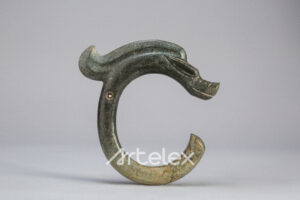This artifact, known as the C-shaped dragon, or sometimes referred to as the “C-dragon” or “pig dragon,” is a significant artifact from the Hongshan culture, a Neolithic civilization that flourished in northeastern China between 4500 and 3000 BCE.
This iconic jade artifact is characterized by its unique curved form, resembling the shape of the letter “C.” The C-shaped dragon typically features a stylized elongated body with a pig-like head, combining attributes of both the dragon and the pig, two animals with important symbolic meanings in Chinese culture.
The C-shaped dragon reflects the sophisticated artistry and cultural complexity of the Hongshan people. It provides valuable insight into the early development of the dragon image in China, a central motif in Chinese mythology and art throughout history. Today, the C-shaped dragon remains a representative symbol of the Hongshan culture’s legacy and its contribution to the broader narrative of ancient Chinese civilization.

